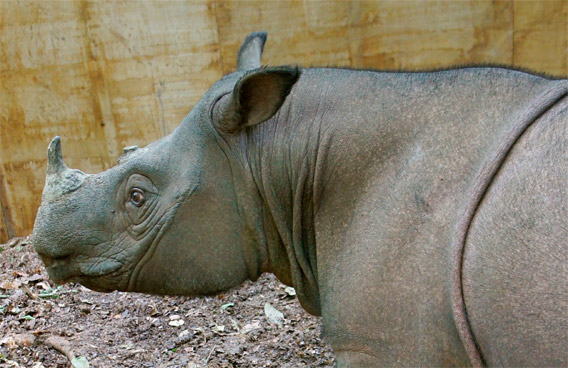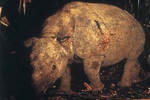
A close up of Puntung taken by Assoc. Prof. Abdul Hamid Ahmad, Chairman of BORA. Photo credit BORA/Abdul Hamid Ahmad.
Conservationists and wildlife officials in the Malaysian state of Sabah airlifted a young female Sumatran Rhinoceros — one of the world’s most endangered animals — to an area of forest where she would encounter a potential partner, reports the Sabah Wildlife Department and Borneo Rhino Alliance. Sumatran Rhinoceros populations are so low, some individuals live in areas where they have no hope of ever finding another rhino.
“This is a fantastic gift for our uphill battle in ensuring the survival of this truly unique species and wonderful timing with Christmas, a time to give thanks for our blessings,” said Laurentius Ambu the Director of the SWD.
“We have monitored her since 2007, and there is no sign that any other rhino has entered her range in the past five years,” added Junaidi Payne the Executive Director of Borneo Rhino Alliance. “This is a stark indication that so few rhinos remain that they are simply not meeting for reproduction.”
The rhino, named Puntung, was moved within Tabin Wildlife Reserve to be close to Tam, a middle-aged rhino rescued from an oil palm plantation in August 2008. Sumatran rhinos are critically endangered due to habitat destruction and poaching. Small populations live on the islands of Sumatra and Borneo — but the number of Bornean rhinos remaining is less than 40.
Conservationists in Sabah are pushing a plan that would involve moving several rhinos to the Borneo Rhino Sanctuary, a large enclosed area covering 20 hectares of natural forest located within Tabin Wildlife Reserve. A similar program is underway in Sumatra.
“This is now the very last chance to save this species, one of the most ancient forms of mammal,” said Laurentius. “We need collaboration and support in our efforts to prevent the extinction of this unique species that was once found in abundance.”
Related articles
Malaysia must take action to avoid extinction of its last rhinos
(11/05/2011) Malaysia must take immediate action to prevent the extinction of the handful of rhinos that survive on the island of Borneo, says a coalition of environmental groups.

(10/25/2011) In 2009 poachers shot and killed the world’s last Vietnamese rhinoceros (Rhinoceros sondaicus annamiticus), a subspecies of the Javan rhino, confirms a report from International Rhino Foundation (IRF) and the World Wide Fund for Nature (WWF). The Vietnamese rhino was the last Javan rhino to survive on the Asian mainland and the second subspecies to vanish, following the extinction of the Indian Javan rhino (rhinoceros sondaicus inermis). The Javan rhino is the world’s most imperiled rhino species with now only around 50 individuals surviving in a single park on its namesake island in Indonesia.
Animal picture of the day: world’s tiniest rhino for World Rhino Day
(09/22/2011) The Sumatran rhino is the world’s smallest species of rhino, but the Bornean rhino—a subspecies of the Sumatra—is even tinier.
How do we save the Sumatran rhino?

(06/06/2011) Some conservation challenges are more daunting than others. For example, how do you save a species that has been whittled down to just a couple hundred individuals; still faces threats such as deforestation, poaching and trapping; is notoriously difficult to breed in captivity; and is losing precious time because surviving animals are so few and far-apart that simply finding one another—let alone mating and successfully bringing a baby into the world—is unlikely? This is the uphill task that faces conservationists scrambling to save the Sumatran rhino (Dicerorhinus sumatrensis). A new paper in Oryx, aptly named Now or never: what will it take to save the Sumatran rhinoceros Dicerorhinus sumatrensis from extinction? analyzes the conservation challenge, while putting forth a number of recommendations.
Down to 50, conservationists fight to save Javan Rhino from extinction

(05/17/2011) Earlier this year, the International Rhino Foundation launched Operation Javan Rhino to prevent the extinction of the critically endangered Javan Rhinoceros (Rhinoceros sondaicus), formerly found in rain forests across Southeast Asia. Operation Javan Rhino is a multi-layered project which links field conservation, habitat restoration, and management efforts with the interests of local governments and communities. The following is an interview with Susie Ellis, Executive Director of the International Rhino Foundation.
Belief and butchery: how lies and organized crime are pushing rhinos to extinction

(05/11/2011) Few animals face as violent, as well organized, and as determined an enemy as the world’s rhinos. Across the globe rhinos are being slaughtered in record numbers; on average more than one rhino is killed by poachers everyday. After being shot or drugged, criminals take what they came for: they saw off the animal’s horn. Used in Traditional Chinese Medicine, which claims that it has curative properties, rhino horn is worth more than gold and cocaine on the black market. However, science proves all this cash and death is based on a lie. ‘There is no medicinal benefit to consuming rhino horn. It has been extensively analyzed in separate studies, by different institutions, and rhino horn was found to contain no medical properties whatsoever,’ says Rhishja Larson.
To save species, Malaysia implements daring plan to trap wild Bornean rhino

(06/13/2010) With less than 40 individuals left in the world, the Bornean rhino is a small step away from extinction. Yet conservationists and government officials in the Malaysian state of Sabah are not letting this subspecies of the Sumatran rhino go without a fight. Implementing a daring last-ditch plan to save the animal, officials are working to capture a wild female to mate with a fertile male named Tam, who was rescued after wandering injured into a palm oil plantation two years ago.
Face-to-face with what may be the last of the world’s smallest rhino, the Bornean rhinoceros

(12/01/2009) Nothing can really prepare a person for coming face-to-face with what may be the last of a species. I had known for a week that I would be fortunate enough to meet Tam. I’d heard stories of his gentle demeanor, discussed his current situation with experts, and read everything I could find about this surprising individual. But still, walking up to the pen where Tam stood contentedly pulling leaves from the hands of a local ranger, hearing him snort and whistle, watching as he rattled the bars with his blunted horn, I felt like I was walking into a place I wasn’t meant to be. As though I was treading on his, Tam’s space: entering into a cool deep forest where mud wallows and shadows still linger. This was Tam’s world; or at least it should be.